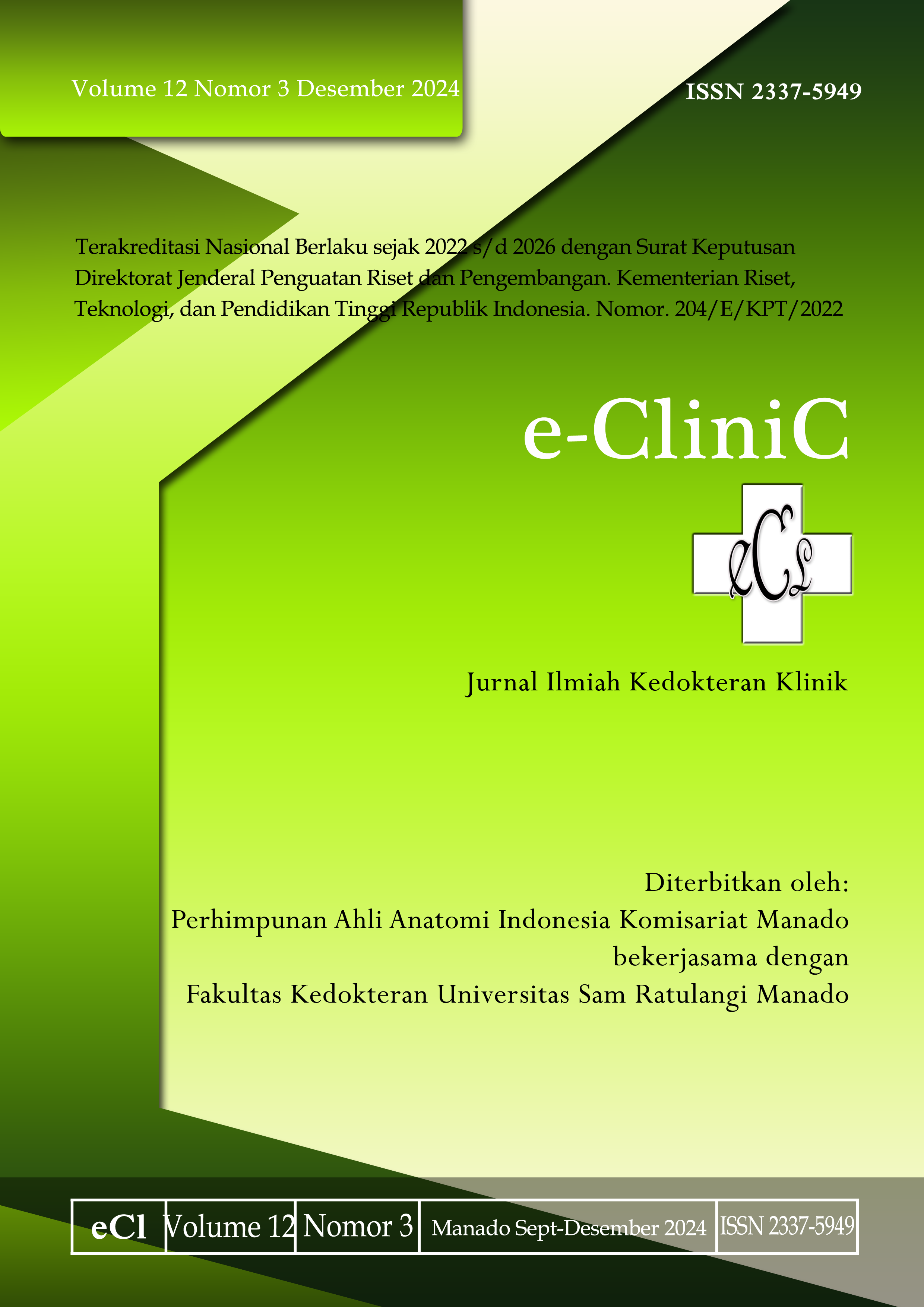Fraktur Komunitif Angulus – Korpus Mandibula dengan Pemasangan Titanium Miniplate dan Srew: Laporan Kasus
DOI:
https://doi.org/10.35790/ecl.v12i3.51821Abstract
Abstract: Communitive fracture of the mandible is quite complicated to achieve good results with the use of titanium miniplates and screws. The challenges faced start from tips and tricks for placing non-rigid miniplate and screw fixation. There are two methods in performing mandibular communitive fracture surgery, namely closed reduction and open reduction. We reported a case of a 19-year-old male referred to Prof. Dr. R. Kandou Hospital, Manado, with open right mandible fracture. The patient was diagnosed with mild head injury, cerebral edema, skull base fracture, communitive fracture of mandibular angulus and corpus, non-displaced maxillary zygoma fracture, and palatal dental sagittal fracture. The patient underwent open reduction surgery with internal fixation using titanium miniplates and screws, and was re-evaluated in the first week after surgery up to three weeks after surgery. The patient's functional chewing and mouth opening were within normal limits. There were no complications such as infection or nerve lesions. In conclusion, communitive mandibular fracture using an open reduction technique with titanium miniplate and screw internal fixation gives satisfactory result.
Keywords: communitive mandibular fracture; open reduction; dental occlusion
Abstrak: Fraktur komunitif mandibula merupakan kasus yang cukup rumit untuk mencapai hasil yang baik dengan penggunaan titanium miniplate dan screw. Tantangan yang dihadapi mulai dari tips dan trik penempatan fiksasi miniplate dan screw yang tidak rigid. Terdapat dua metode dalam melakukan operasi fraktur komunitif mandibula, yaitu reduksi tertutup dan reduksi terbuka. Kami melaporkan kasus seorang laki-laki 19 tahun dirujuk ke RSUP Prof. Dr. R. Kandou, Manado dengan patah tulang dagu kanan terbuka. Pasien didiagnosis dengan cedera kepala ringan, edema serebri, fraktur basis krani, fraktur angulus - korpus mandibula dekstra komunitif, fraktur zigoma pars maksilaris dekstra non-displaced, dan fraktur sagital dental palatal. Pasien dilakukan operasi reduksi terbuka dengan fiksasi internal. Evaluasi dilakukan pada minggu pertama paska operasi, hingga tiga minggu paska operasi. Didapatkan fungsional mengunyah dan membuka mulut pasien ini dalam batas normal, serta tidak didapatkan komplikasi seperti infeksi maupun lesi saraf. Simpulan kasus ini ialah fraktur mandibula komunitif dengan teknik reduksi terbuka dan fiksasi internal titanium miniplate dan screw memberikan hasil yang memuaskan.
Kata kunci: fraktur mandibula komunitif; reduksi terbuka; oklusi dental
References
Afrooz PN, Bykowski MR, James IB, Daniali LN, A Clavijo-Alvarez JA. The epidemiology of mandibular fractures in the United States, part 1: a review of 13,142 cases from the US National Trauma Data Bank. J Oral Maxillofac Surg. 2015;73(12):2361-6. Doi: 10.1016/j.joms.2015.04.032
Bouloux G. A comparison of the Champy and AO techniques for mandibular fractures in a Level I Urban Trauma Center. J Oral Maxillofac Surg. 2010;68(9):e19–e20. Doi:10.1016/j.joms.2010.06.028
Feniar JG, Kawano H, Camolesi GCV, Palmieri M, Sobral SdS, Duarte FL, et al. Extraction of impacted third molar with preventive installation of titanium miniplate: case report. Ann Med Surg (Lond). 2020; 49:33-36. Doi: 10.1016/j.amsu.2019.11.014
Kamath RAD, Bharani S, Hammannavar R, Ingle SP, Shah AG.. Maxillofacial trauma in Central Karnataka, India: an outcome of 95 cases in a regional trauma care centre. Craniomaxillofac Trauma Reconstr. 2012;5(4):197-204. Doi: 10.1055/s-0032-1322536
Kanno T, Sukegawa S, Nariai Y, Tatsumi H, Ishibashi H, Furuki Y, et al. Surgical treatment of comminuted mandibular fractures using a low-profile locking mandibular reconstruction plate system. Ann Maxillofac Surg. 2014;4(2):144-9. Doi: 10.4103/2231-0746.147103
Lee K, Yoon K, Park K-S, Cheong J, Shin J, Bae J, Ko I, et al. Treatment of extensive comminuted mandibular fracture between both mandibular angles with bilateral condylar fractures using a reconstruction plate; a case report. J Korean Assoc Oral Maxillofac Surg. 2014;40(3):135–9. Doi: 10.5125/jkaoms.2014.40.3.135
Schenkel JS, Obwegeser J, Zemann W, Rostetter C, Tandon R, Metzler P, et al. Outcome of comminuted mandibular fracture repair using an intraoral approach for osteosynthesis. J Craniofac Surg. 2014;25(6):2033-7. Doi: https://doi.org/10.1097/SCS.0000000000001103
Morris C, Bebeau NP, Brockhoff H, Tandon R, Tiwana P, et al. Mandibular fractures: an analysis of the epidemiology and patterns of injury in 4,143 fractures. J Oral Maxillofac Surg. 2015;73(5):951.e1-951.e12. Doi: 10.1016/j.joms.2015.01.001
Sahudi. Kecelakaan lalu lintas penyebab nomor satu patah tulang wajah. 2014. Avalailable from: https://fk.unair.ac.id/archives/2014/01/06/
Saito DM, Murr AH. Internal fixation of mandibular angle fractures with the Champy technique. Operative Techniques in Otolaryngology-Head and Neck Surgery. 2008;19(2):123-7. Available from: https://doi.org/10.1016/j.otot.2008.04.006
Sjamsudin E, Mardhatillah A, Trihapsari A, Wulanda C, Melyana S, Nissa UW. Initial treatment of mandibular fracture: serial case. International Journal of Science and Research (IJSR). 2018;9(1):1535-9. Doi: 10.21275/ART20204330
Yildirgan K, Zahir E, Sharafi S, Ahmad S, Schakker B, Ricklin ME, et al. Mandibular fractures admitted to the emergency department: data analysis from a swiss level one trauma centre. Emerg Med Int. 2016:2016:3502902. Doi: 10.1155/2016/3502902
Downloads
Published
How to Cite
Issue
Section
License
Copyright (c) 2024 Riston R. Sitompul, Nico Lumintang, Sherly Tandililing

This work is licensed under a Creative Commons Attribution-NonCommercial 4.0 International License.
COPYRIGHT
Authors who publish with this journal agree to the following terms:
Authors hold their copyright and grant this journal the privilege of first publication, with the work simultaneously licensed under a Creative Commons Attribution License that permits others to impart the work with an acknowledgment of the work's origin and initial publication by this journal.
Authors can enter into separate or additional contractual arrangements for the non-exclusive distribution of the journal's published version of the work (for example, post it to an institutional repository or publish it in a book), with an acknowledgment of its underlying publication in this journal.
Authors are permitted and encouraged to post their work online (for example, in institutional repositories or on their website) as it can lead to productive exchanges, as well as earlier and greater citation of the published work (See The Effect of Open Access).







